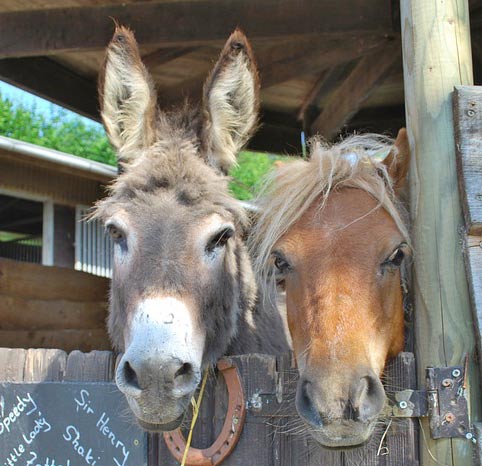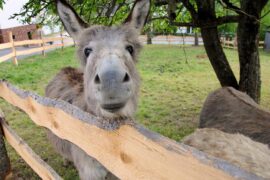It is generally recommended to provide shelter for donkeys at night, especially in colder or wetter climates. Donkeys can be susceptible to hypothermia and other health issues if left exposed to harsh weather conditions. Providing a stable or shelter with proper ventilation, bedding, and access to food and water can help keep them healthy and comfortable. Additionally, stabling at night can help protect them from predators and other potential dangers. However, it is important to ensure that the stabling is appropriate for donkeys and meets their specific needs for space, ventilation, and socialization.
Stabling donkeys: things to keep in mind
When stabling donkeys, it’s important to ensure that their needs are met to keep them healthy and comfortable. Here are some tips on how to stable donkeys:
- Size and space: The stable should be spacious enough to allow the donkey to stand, lie down, and move around comfortably. A minimum of 12 x 12 feet is recommended for an adult donkey. The stable should also be well-ventilated, with windows or ventilation grilles to allow fresh air to circulate.
- Bedding: The stable should be lined with a soft, absorbent bedding material such as straw, shavings, or wood pellets. The bedding should be kept clean and dry to prevent the growth of bacteria and mold.
- Feeding: Donkeys should have access to clean, fresh water at all times. They should also be fed hay or grass, which should be provided in a hay rack or feeder to keep it off the ground.
- Socialization: Donkeys are social animals and should be kept in pairs or small groups whenever possible. This helps to prevent loneliness and boredom.
Alternative to stable for donkeys
If stabling is not an option for donkeys, there are alternative methods of providing shelter and protection for them. Some options include:
- Run-in shed: A run-in shed is a simple three-sided shelter that provides protection from the elements. It can be made from wood, metal, or other materials and should be placed in a well-drained area.
- Field shelter: A field shelter is a larger version of a run-in shed and can provide shelter for multiple donkeys. It can be constructed using similar materials to a run-in shed and should be placed in a well-drained area.
- Barn: A barn can provide shelter for multiple donkeys and can also be used for feeding, grooming, and other tasks. It should be well-ventilated and have enough space for the donkeys to move around comfortably.

Size of a stable for donkeys
The size of a stable for donkeys depends on the size of the donkeys themselves. Generally, a minimum stable size of 12 x 12 feet (3.7 x 3.7 meters) is recommended for an adult donkey. This allows them to stand, lie down, and move around easily. However, if you have larger donkeys or if you plan to keep them in pairs or small groups, you may need to provide a larger stable or run-in shed to accommodate them. It’s important to ensure that the stable provides adequate ventilation, light, and protection from harsh weather and predators. Additionally, the stable should be kept clean and well-maintained to ensure the health and well-being of the donkeys.
Other steps to make your donkeys comfortable
In addition to a suitable stable or shelter, there are several other things that can help make donkeys comfortable at night:
Temperature regulation
Donkeys are susceptible to hypothermia, so it’s important to keep them warm during cold nights. This can be achieved by providing adequate insulation in the stable, such as by using thick walls and a well-insulated roof. You can also use heat lamps or other heating devices, but these should be used with caution to avoid fire hazards.
Lighting
Donkeys may feel more comfortable with a dim light source in the stable, such as a low-wattage bulb, which can help reduce anxiety and promote restful sleep. Additionally, having some ambient light in the stable can help make it easier for you to check on your donkeys during the night, if needed. However, it’s important to avoid using bright or harsh lighting, as this can disrupt their natural sleep cycle and cause stress.
Conclusion
In conclusion, stabling donkeys at night is a common practice to provide them with a safe and comfortable shelter. While donkeys are adaptable and can live outdoors, stabling can protect them from extreme weather conditions and predators. A well-designed stable should provide adequate ventilation, lighting, and temperature regulation, as well as access to food and water. However, stabling is not the only option, and alternative forms of shelter, such as run-in sheds or pasture shelters, may also be suitable depending on the local climate, terrain, and available resources.

![Should Donkeys Be Stabled at Night? [With Alternatives to a Stable] Should-donkeys-be-stabled-at-night](https://donkeyonfarm.com/wp-content/uploads/2023/04/Should-donkeys-be-stabled-at-night.jpg)

![How Cold is Too Cold for a Donkey? [Plus Tips to Keep Them Warm] How-Cold-is-Too-Cold-for-a-Donkey](https://donkeyonfarm.com/wp-content/uploads/2022/09/How-Cold-is-Too-Cold-for-a-Donkey-270x180.jpg)
![How to Get Rid of Flies on Your Donkey? [Plus Prevention Methods] How to Get Rid of Flies on your Donkey](https://donkeyonfarm.com/wp-content/uploads/2022/05/How-to-Get-Rid-of-Flies-on-your-Donkey-270x180.jpg)
![How Much Can Donkeys Carry? [Avoid Burdening] How-much-can-donkeys-carry](https://donkeyonfarm.com/wp-content/uploads/2022/04/How-much-can-donkeys-carry-270x180.jpg)
